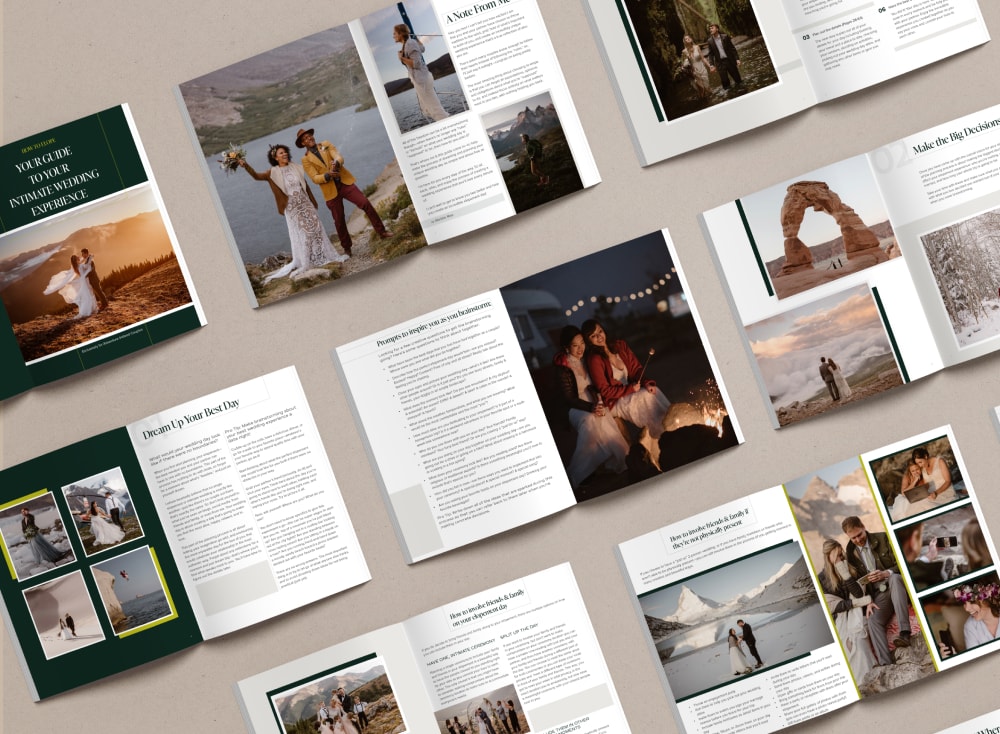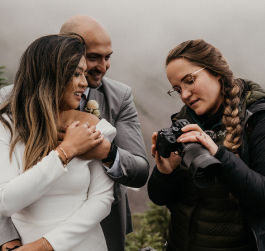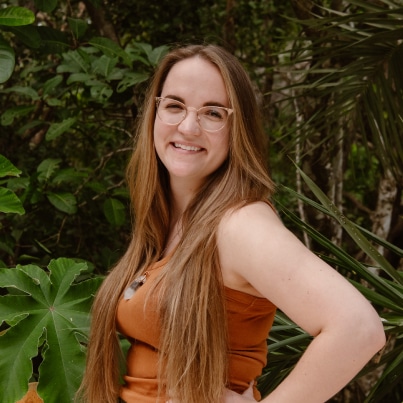Be Prepared: Expertly plan, gear up, & execute an adventurous outdoor wedding while exceeding client’s expectations
Hey elopement photographers—ever wonder how the heck hiking elopements really go down? Are you curious about what exactly goes into setting up and crafting the most epic hiking experience for an eloping couple? In this video, I break down everything you need to know to prepare, plan, and execute the ultimate hiking wedding for adventurous marriers!
Below, I go into exact detail about what I carry with me on short hikes, day hikes, and overnight backpacking elopements. I discuss the importance of having a backup plan and offer key insight into what makes a hiking elopement perfect for the couple getting married (hint: a perfect day doesn’t mean everything went according to plan)!
Photographing hiking elopements requires a hybrid approach—I get to combine my experience as a hiker and a wedding photographer. Together, these two things that I love so much have given me the opportunity to build a career doing the best job I can possibly imagine, for couples who love to be outside as much as I do.
I have a separate blog post dedicated to the basics of how to become an elopement photographer… but if you want to learn more about becoming an experienced adventure elopement photographer, this is it—the insight you’ve been looking for into exactly what it takes to document hiking elopements.
So if this is something you want to do, you don’t want to miss this!
Why Hiking Elopements Require More Work Than ANY Other Kind of Wedding Photography
Hiking elopements combine the experience of being an outdoors person with the experience of being an elopement photographer—no other wedding or elopement scenario requires the skills of such a diverse set of experiences to be done safely. By no means am I saying all photographers who take on hiking elopements must spend their weekends summiting mountains—in the same way that there are trails for every access & skill level, you’ll simply want to take on hiking elopements that are within your comfort zone as a hiker. A photographer who wants to photograph adventurous weddings is probably drawn to outdoor adventures in their personal time too, and that’s experience you’ll appreciate having in this field.
Hiking elopements require being more prepared than any other kind of wedding photography—you need to pack camera gear AND outdoor gear. Hiking elopements combine all the possibilities that can happen on a wedding day with the possibilities that can happen outdoors. There could be a wardrobe malfunction or there could be a rainstorm. I don’t say this to scare you—but if you’ve suggested an outdoor location for a couple’s wedding day, you’ve inherently taken on a bit of liability to ensure you can lead them through the experience safely.
A huge part of what I do as an elopement photographer is help couples discover their dream wedding location. When a couple chooses a place that requires hiking, I take extra steps to ask them about their skill levels, comfort, and preparedness for this particular outdoor setting. I actually put in more work throughout the planning process for elopements than I ever did as a wedding photographer, and it’s because I consider myself a service provider—I want to do everything I can to make sure the two getting married have the BEST DAY EVER!
Obviously we all hope nothing ever goes wrong, but that’s simply not how life works—and it’s certainly not how Mother Nature works either. The right gear is essential to safely adventuring outdoors, and I think of gearing up a little like the warning you get every time you fly—the best way to take care of those around you is by putting your own oxygen mask on first. To translate, this means I make sure I have all the right gear, so I can then offer assistance to couples on their wedding day.
How to Gear Up for a Hiking Elopement
The gear necessary to photograph a hiking elopement is a mixture of outdoor gear and wedding gear, and one of the best bits of advice I can give is to be ready with all things your couples could possibly have forgotten in the rush to pack for their big day. You’re not just gearing yourself up to take photos—instead think, “what is essential to ensuring this event can take place?” Then, make sure you’ve brought those things. Ideally, every couple will bring each thing you’ve recommended, but even the best-intentioned couples can have total brain farts and forget the most essential items.
Part of my process preparing couples for their hiking elopement is giving them a realistic expectation for weather, altitude, and environment. Still, I’ve worked with couples coming from warmer climates who simply didn’t understand (or didn’t believe me) when I said they might see snow in Colorado in July. Instead of realizing the morning of an elopement that there’s no way they can go through with their plan comfortably, I see it as part of my job description as an elopement photographer to mitigate risk by being super prepared.
The level of preparedness necessary will change a bit depending on how demanding this hiking elopement is going to be. There are basically 3 different kinds of hiking elopement, and each requires a different set of gear: short hike, day hike, & overnight backpacking trip. A lot of the gear I bring for each of these situations overlaps, but I’ll break down what I bring in each scenario below. While the list is extensive, every single thing is something I’ve added to my gear pile because I’ve either used it during a hiking elopement or wished I had it with me at some time. Depending on where you shoot, what type of hiking elopements you photograph, and the individual needs of the couples you work with, your personal packing list might be a bit different.
What I Pack for Hiking Elopements
No matter the kind of hiking elopement, I always bring the same amount of camera gear with me: 2 bodies, 3-5 lenses, spare batteries, rain covers, lots of memory cards, and a dual camera harness. In an effort to reduce weight when I can, I’m ultra-efficient with the lenses I do bring—I’d avoid a focal length I know won’t be useful for a certain location or avoid doubling up on similar lenses. One of the best things about photographing events outside is that I can quite literally step closer or farther away to get the perspective I need for the shot—you can’t do that as flexibly or reliably indoors.
I also always carry my “emergency kit,” which is a mix of simple medical emergency gear, and a “bridal suite.” My emergency kit consists of: antibiotic cream, medicine for a headache or dizziness, an antihistamine, ginger chews, eye drops, alcohol swabs, bandaids, blister gels, moleskins, hand sanitizer, a mini sewing kit, black & white thread, hand warmers, superglue, sunscreen, tissues, lint roller, Tide To Go pen, multitool with a wine bottle opener, blistex, chapstick, double-sided fashion tape, safety pins, bobby pins, bug repellant wipes, WAG bag & toilet paper, hairspray, hair ties, dry shampoo, straight pins, mirror, comb, tweezers, and nail clippers.
I also usually end up using a hiking bouquet hack with couples who bring flowers—I soak a rag in water, wrap that rag around the flower stems, then stuff it into a waterproof dry bag. I then securely shove that bag with the stems down & flowers upright into an outside pocket in the hiking backpack or zip it into the backpack with the flowers sticking out the top.
One of the most obviously important pieces of gear is a hiking backpack. I have 3 different packs depending on the length of hike, and each one was specifically fitted so I can comfortably carry all the gear I need. Remember, a hiking pack full of camera gear is going to weigh more than you’d probably carry for just a hike – because of this you’ll want to look for packs with better weight distribution and a thick hip belt. I’ve found there isn’t a perfect hiking camera backpack on the market—instead, I’ve outfitted technical hiking packs to become customized camera bags. This solution is still the best one I’ve discovered, but if anyone ever invents a truly hiking-specific camera bag, I’d be willing to try it!
Gear for a short hike
Ultralight backpack, snacks, water, camera gear, & emergency kit.
Gear for a day hike
30L hiking backpack decked out as a dual-camera harness, tripod, water, snacks, compass, thermometer, Shootsac for carrying spare lenses, flashlight, emergency kit, camera gear (including my dual-camera harness for when I take off my pack), backpack rain cover, rain jacket, & layers for warmth.
Gear for an overnight backpacking trip
50-70L hiking backpack, everything listed for a day hike, tent, sleeping bag, more layers for warmth, spare socks, water filter, cooking gear, and anything else necessary for camping in that area.
I also always have a bag that stays in the car packed full of extra gear, some of which only gets used at the trailhead, but some things come in handy for the hike. It’s basically my Mary Poppins bag of stuff to respond with any time I hear “I wish we’d brought…” Before heading up a trail I always make note of what I’ve brought and ask the couple one last time if we need to gear up more before heading out.
Gear I always have in the car
A bigger emergency kit with more serious stuff, nude fleece-lined leggings (in multiple color shades & sizes), headlamps, spare batteries, microspikes & yaktrax, fingerless gloves (in multiple colors & sizes), plain black gloves, hats (in multiple colors), hand warmers, toe warmers, body warmers, a blanket, cute photo-ready jackets & wraps, a travel towel, rain ponchos, sunscreen, bug spray, snacks, espresso shots, and a hairbrush.
At the beginning of every wedding season I go back through this gear and ensure nothing I have will expire if it needs to be used (sunscreen, snacks, & hand warmers all expire pretty quickly). It would be a real bummer to have a cold front come in, load up on hand warmers expecting they will get you through the session, and then find that they won’t stay warm no matter what you do!
Probably the most often used items that I pack for couples are headlamps and hand warmers. Though, I swear the espresso shots and snacks have earned me more 5-star reviews than anything else! Getting a spare set of headlamps and a box of hand warmers to save the day is a small upfront investment when the alternative is a dangerous hike back in the dark, or a session that has to end early because of the cold.
Backup Plans – Not Just A Bonus, a Requirement
Having a backup plan for a hiking elopement is just as important to your preparedness as having the right hiking boots – without a Plan B in place, you’re crippling yourself. Unlike photographing a venue-based wedding or elopement, hiking elopement plans are inherently less secure. If a wedding is occurring at a venue, there’s not much reason for a Plan B because that building will be accessible rain or shine. However, a viewpoint, trail, or mountain peak might be inaccessible or unviewable if something as simple as a rainstorm pops up. Having a secondary location can be the difference between a total bust and a totally successful wedding day for a couple.
There are a few things that make a backup plan solid:
- Your backup location should be more easily accessible than your first choice. The reason for this is that if you’ve already begun hiking up to one spot and found it inaccessible, you don’t then want to head to a second location totaling a much harder day than the couple signed up for.
- Your secondary location should be at a different elevation. Especially here in Colorado, a mountain range experiencing inclement weather at 10k feet might look totally different than somewhere only a few miles away at 8k feet. If a significant elevation change isn’t the solution for your area, think of other topographic features that might ensure the chance of a different weather pattern—mileage, hills, or valleys between two places are good things to look for.
- If your couple is open for it, an indoor or backyard secondary location might be ideal. A backyard wedding can happen in most weather conditions (clear umbrellas are a good thing to have in case of rain) and then there is no hiking necessary to get the couple indoors to cozy up afterward.
- Don’t think of a backup location as lesser—some of my favorite photos I’ve ever taken actually occurred after a “failed” attempt at Plan A. The act of stepping up to ensure a couple have the chance to say their vows in a place that feels just right is more important than sticking to a plan.
If you end up having to switch gears last minute because of an unforeseeable hiccup, be kind to yourself. Remember, there are things you can control and things you can’t. When I started photographing hiking elopements, I’d catch myself upset over stuff that I was never in control of—like if it rained. No, rain was not my fault. Instead, I consider what I can control and focus on performing those parts of my job, even when things aren’t going 100% according to plan. It is my job that my couples have a good time, and a solid backup plan that I believe in helps me be a better service provider to ensure that positive experience.
The Secret to Success – Flexibility & Preparedness
So much can happen during a hiking elopement that is totally out of your control. Weather, wildlife, and altitude can all derail plans in a way that you need to be prepared for to get your couple safely back to the trailhead. A huge part of handling these challenges comes down to having the right gear, but you also need to have the right mindset. Plan for the worst, and hope for the best. Do your best to set everyone up for success, and then don’t become so attached to the plan that you’re unable to pivot if things aren’t looking right for this moment at this location.
As you prepare your couple for their hiking elopement, try to get a good feel for their skill level. Have they hiked this many miles before? Have they spent time at this elevation before? How did those past experiences make them feel? Even the most experienced mountaineer can become affected by altitude if they don’t take care of their body before a big day, which is something I keep in mind, especially with couples traveling to Colorado where many hikes are significantly higher in elevation. I’ll remind couples to get enough sleep the night before, drink lots of water in the days leading up to their elopement, and make sure they eat.
Always be ready to go with the flow—I can promise a couple that they’ll have an adventure and that they’ll be married at the end of the day if they wish. But I can’t promise a location will work out, and I can’t promise we won’t need a backup plan. By suggesting a location, you’re taking on extra levels of liability—be sure you haven’t promised more than you can guarantee you’ll be able to deliver. By expressing realistic expectations at the outset for what could happen during a hiking elopement, you’re setting everyone up for success.
Being able to pivot and be flexible is something I build into my schedule—I basically never plan elopements back to back because I want to be able to go the extra mile for a couple on their elopement day. For example—what if I meet up with a couple in the morning and it’s raining? We decide to head up the trail anyway because the weather calls for a break in the clouds, but after a while, there’s no sign of the deluge slowing. I’m looking over at the couple, bundled in their rain gear, and can’t imagine it’ll be fun for them to change into wedding attire under these conditions—there is no view and their vow books would get soaked. At this point, I’d probably say something like, “it’s 100% up to you two, but I don’t think the weather is going to be what we were hoping for—you can either say your vows to each other as you planned, or we can head back into town and grab some hot food and reconvene.” Maybe we’ll be able to go to a backup location later in the day, or maybe even another attempt the next morning would be better. This is supposed to be the moment that a couple says their vows to each other to commit their lives to each other—the last thing I want is for them to hate the experience!
In this example, I’m not thinking “this couple hired me for x hours and when the clock strikes 8, I’m out of here!” No, instead I’m thinking, “what can I do to ensure this couple looks back on the day they shared their vows and remembers the experience as one of the best days of their lives?” I don’t pack my schedule because if the weather is terrible or someone gets sick, I want to be able to go above and beyond to find another location or reschedule. Flexibility is an essential part of this job, and a lot of outdoor experience can certainly mitigate risks but going with the flow will help you craft a positive experience those times when plans have to change.
Curious about what else you can do to go above & beyond for your couples, throughout the whole process? Check out this blog post on how to provide customer service that gets five-star reviews!
How to Plan a Hiking Elopement Timeline
Planning a timeline for a hiking elopement isn’t like planning the timeline for a hike or a wedding—as with everything so far, it’s a combination of the two. Unlike a traditional wedding day, there will be parts of the timeline that aren’t about the getting married part of the day, but similarly, it’s not just about getting to the destination.
A basic rule of thumb I give for every hiking elopement is to plan 1 hour for each mile. It’ll rarely take a whole hour to hike a mile, but this gives couples the opportunity to spend time enjoying their surroundings, getting changed at the destination, and having a ceremony that doesn’t feel rushed at all. So, a 6-mile hike would never be booked for less than 6 hours. If the couple wanted photos getting ready beforehand or wanted photos back at their rental afterward, the day would be even longer.
Do couples hike in their clothes or change at the location? Well, it depends.
I get asked all the time if couples hike up in their wedding clothes—it depends on the location, the length of trail, and the time of day. If the hike is long or steep, couples often change at the top and might hike back down in their wedding attire. If it’s a sunrise elopement, they usually always hike up in hiking clothes because it’s easier to bundle up for warmth, and there is very likely to be privacy at the destination at sunrise. If the hike is short, and not likely to require a ton of technical or strenuous activity, couples sometimes hike up in their wedding attire. I’ll often pack a towel to hang out as an impromptu dressing room, or even a lightweight tent that can be put together quickly to become a cozy, private place to get dressed.
If a couple is changing at the top of a hike, they’ll usually do some touchup on hair and/or makeup as well. A really good setting spray and some extra makeup to bring along for touch ups is something worth mentioning to a couple who might want to clean up after hiking to their ceremony spot.
Do you photograph along the trail or only at the destination?
This is another question I get asked often, and 99% of the time, if you were to look through a gallery from a hiking elopement, you’d see that I’m photographing throughout the hike. If the weather is particularly awful, I might only have one camera out to get a few snaps along the way, but it’s a high priority that I document the whole day. Even the hike is a part of the story for a couple having an adventurous wedding, and that’s why I’ve rigged my hiking backpacks to double as dual camera harnesses.
I don’t think of hiking as “travel time” when I’m planning out an elopement timeline for a couple. The hiking is a part of the whole experience, and I’m certainly “working” throughout. Even a drive to the trailhead, if we’re carpooling or taking a jeep tour, is documented to be a part of the story for the couple getting married. While there will be a specific place and time throughout the day when a couple says their vows during a hiking elopement, my documentation of their experience is no less thorough than when I was photographing traditional weddings—getting ready, first looks, portraits, ceremony, reception, etc. The “stages” of an elopement day might look a bit different than a traditional wedding, but I think it’s a disservice to view the journey as less important than the destination.
As you can see, there’s a lot to consider when it comes to planning a hiking elopement. I hope this guide has helped you see why I’m such a believer in being prepared, how you can prepare yourself for situations by bringing the right gear, and when flexibility will come in handy to ensure you couples have the BEST day!
Ready to take your hiking elopement to the next level? A huge advantage of hiking elopements is that you’re usually in places without a lot of light pollution—which is perfect for astrophotography. Check out this blog post to learn about how to seize the opportunity and take epic star photos!



















